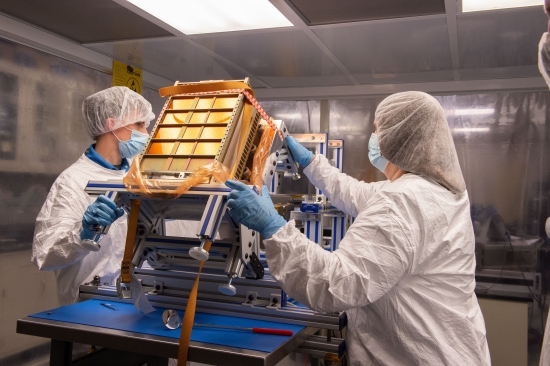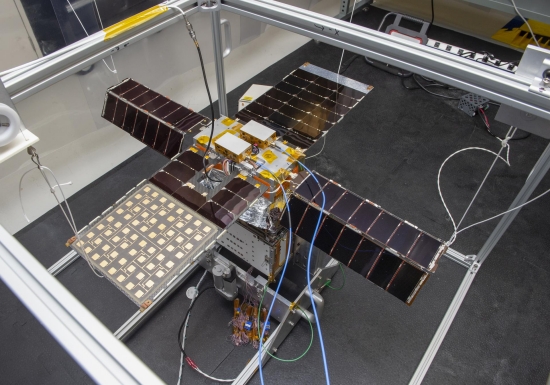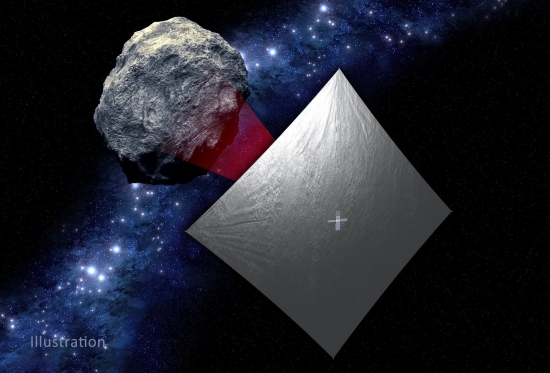Near-Earth Asteroid Scout (NEA Scout) is a CubeSat mission designed and developed at NASA’s Marshall Space Flight Center in Huntsville and the Jet Propulsion Laboratory in Pasadena. I’m always interested in miniaturization, allowing us to get more out of a given payload mass, but this CubeSat also demands attention because it is a solar sail, the trajectory of whose development has been a constant theme on Centauri Dreams.
And while NASA has launched solar sails before (NanoSail-D was deployed in 2010), NEA Scout moves the ball forward by going beyond sail demonstrator stage to performing scientific investigations of an asteroid. As Japan did with its IKAROS sail, the technology goes interplanetary. Les Johnson (MSFC) is principal technology investigator for the mission:
“NEA Scout will be America’s first interplanetary mission using solar sail propulsion. There have been several sail tests in Earth orbit, and we are now ready to show we can use this new type of spacecraft propulsion to go new places and perform important science. This type of propulsion is especially useful for small, lightweight spacecraft that cannot carry large amounts of conventional rocket propellant.”

Image: Engineers prepare NEA Scout for integration and shipping at NASA’s Marshall Space Flight Center in Huntsville, Alabama. Credit: NASA.
The spacecraft, one of several secondary payloads, has been moved inside the Space Launch System (SLS) rocket that will take it into space on the Artemis 1 mission, an uncrewed test flight. Artemis 1 will be the first time the SLS and Orion spacecraft have flown together (the previous launch was via a Delta IV Heavy). NEA Scout, which will deploy after Orion separates, has been packaged and attached to an adapter ring connecting the SLS rocket and Orion.
Once separated from the launch vehicle, NEA Scout will deploy a thin aluminized polymer sail measuring 85 square meters (910 square feet). In terms of sail deployment, we can think of the mission as part of a continuum leading to Solar Cruiser, which will feature a sail 16 times larger when it launches in 2025. Deployment will be via stainless steel alloy booms. Near the Moon, the spacecraft will perform imaging instrument calibration and use cold gas thrusters to adjust its trajectory for a Near-Earth Asteroid. The solar sail will provide extended propulsion during the approximately two year cruise to destination. The final target asteroid has yet to be selected.

Image: NASA’s NEA Scout spacecraft in Gravity Off-load Fixture, System Test configuration at NASA’s Marshall Space Flight Center in Huntsville, AL. Credit: NASA.
The pace of innovation in miniaturization is heartening. I note this from a 2019 conference paper describing the final design and the challenges in perfecting the hardware (citation below):
The figurative explosion in CubeSat components for low earth orbital (LEO) missions proved that spacecraft components could be made small enough to accomplish missions with real and demanding science and engineering objectives. Unfortunately, these almost-off-the-shelf LEO components were not readily usable or extensible to the more demanding deep space environment. However, they served as an existence proof and allowed the NEA Scout spacecraft engineering team to innovate ways to reduce the size, mass, and cost of deep space spacecraft components and systems for use in a CubeSat form factor.

Image: Illustration of NEA Scout with the solar sail deployed as it flies by its asteroid destination. Credit: NASA.
At destination, NEA Scout is to perform a sail-enabled low-velocity flyby at less than 30 meters per second, with imaging down to less than 10 centimeters per pixel, which should enlarge our datasets on small asteroids, those measuring less than 100 meters across. Says principal science investigator Julie Castillo-Rogez (JPL):
“The images gathered by NEA Scout will provide critical information on the asteroid’s physical properties such as orbit, shape, volume, rotation, the dust and debris field surrounding it, plus its surface properties.”
The more we learn about small asteroids, the better, given our need to track trajectories and potentially change them if we ever find an object on course to a possible impact on Earth.
The presentation on NEA-Scout is Lockett et al., “Lessons Learned from the Flight Unit Testing of the Near Earth Asteroid Scout Flight System,” available here.



Here a link with an interesting video of a sail deployment test. https://www.nasa.gov/content/nea-scout
The party balloons made it an even more festive event. ;p
A few thoughts:
1. Having watched several videos of the construction of this sail, it is clear that it is still a very artisanal process to build such a craft. The real value of miniaturization comes when a standard design can be used in a factory setting to manufacture these in volume to drive down the cost. Like autos, different models can be built for specific tasks, and every 2 to 3 yers, an upgraded model appears to use the latest technology, rather than using decades old technology baked-in for the bigger exploration craft. They needn’t displace big exploration craft, but complement them, just as small ships complement container ships and vans, autos, and motorcycles complement big rig trucks.
2. We need to establish low cost access to space. I appreciate that this tiny craft is just a piggyback payload, but the obscene costs per flight of the SLS really negates the purpose. Reusable launchers are needed, whether high capacity payload launchers operating like cargo container ships or smaller rockets that deliver a single payload.
3. Fleets of such sail craft could do all sorts of useful continuous monitoring of celestial objects, including looking for “lurkers” in likely locations. They extend our surveillance off-planet in numbers that allow redundancy to reduce construction costs to allow for failures to deploy, failure due to accidents, and shorter lifespans.
As I understand it (which is to say I cribbed Wikipedia a second ago), cubesat launches cost about $100,000. If the solar sail technology can be mass produced and made reasonably durable, then a decent science budget could have these things running around all over. Imagine you send one of them skimming past Europa at a thousand meters and the radiation or a small navigational mishap destroys it. Well, fine … just redeploy a few more from nearby missions! If they don’t have the power to send decent amounts of data, well, fine … set them to navigate back to a mothership, or all the way to Earth if need be to get the signal out. At a hundred grand, one might even be tempted to repurpose a few as impact probes for the others to study … though some proud papa will be angry with you!
“86 square meters (282 square feet)”
At least one of these numbers must be wrong. The linear ratio was used rather than that for area. Sorry to editorialize but I can’t help noticing these things since I live in a metric country.
Right you are. Am trying to get the right number from a source.
Wikipedia says: “85 m2 (910 sq ft)” Will change the text in my post.
I should have caught this because it’s also in the presentation on NEA Scout that I posted the citation to in this post!
Congratulations on a truly excellent web site.
Just one point on this post, though. You say “86 square meters (282 square feet)”. A square metre is about 10 square feet. I do hope that the mistaken conversion is yours and that NASA are not repeating their earlier mistakes.
Thanks for the kind words, Joe. Glad to have you here. Re the sail size: I pulled the figure from NASA’s NEA Scout page: “a solar sail measuring 282 square feet, or 86 square meters.” And yes, the figure is wrong, as you note. Hmmmm…. Elsewhere on the NASA site the sail is described as “about the size of a racquetball court.” Can someone plug in the size of a racquetball court? If so, please do!
800 sqft
https://en.wikipedia.org/wiki/Racquetball
I want a dedicated SLS sundiver with hydrogen upper stage sending a huge sail to Jupiter. NTRs need LH2…
As this will not have “run out of fuel” once it reaches its first target, is there a plan to further utilise it?